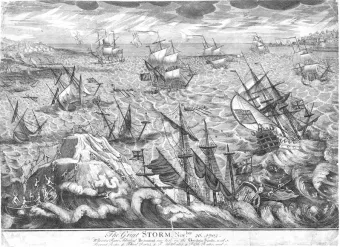
- A new study led by the National Oceanography Centre has shed light on long-term changes in storminess across Europe.
- Windstorms are one of the most damaging natural hazards across Europe, having severe impacts on people and property.
- Scientists used barometric pressure data to construct the longest-ever instrumental-based storm series, revealing similarities and differences between recent stormy periods and those in the early nineteenth century.
- The study revealed that increases in winter storminess during the last 30 years are similar to the early 19th century, but storminess in the earlier period also extended to the spring and autumn seasons.
A brand-new study published in Communications Earth and Environment led by the National Oceanography Centre (NOC) has given new insight into the long-term changes in storm patterns across Europe.
Windstorms are one of the most damaging natural hazards across Europe, having severe impacts on people and property. In the past decade, northwest Europe has experienced several stormy autumn-winter seasons. The 2021/2022 season was particularly severe with a sequence of intense low-pressure systems crossing the region that caused wind damage, transport disruption and coastal storm surges. The winter of 2013/2014 was also significant, with data indicating that the conditions experienced were unprecedented in the last 150 years.
For years, based on historical accounts and other sources, scientists have known that that the 1790-1820s was also a particularly stormy period in Europe. However, knowledge of how this relates to today’s storm patterns and insight into what’s causing them has been lacking.
To gain a clearer understanding of Europe’s changing storm climate, scientists used barometric pressure data from sites around the English Channel, reaching as far back as the late stages of the Little Ice Age (a period of cooler climate in the North Atlantic Region between the 14th and 19th centuries) to construct the longest ever instrumental-based storm series.
The study revealed for the first time that the increased winter storminess experienced over the last 30 years was similar in frequency and intensity to that experienced in the late 19th Century. However, it also revealed crucial differences between the periods. The study showed that there has been an increase in storminess since the 1990s has been confined to the winter season, which is correlated with a strengthening and north-eastward shift of the North Atlantic jet stream.
This contrasts with conditions during the early nineteenth century where increased storminess extended into the spring and autumn seasons. There were even significant stormy summer seasons during that time - such as the notorious year-without-a-summer of 1816 - which have become much less likely to occur in modern times.
Dr Richard Cornes, Marine Climatologist at NOC and Lead Author of the study said: “Further work is required to determine the potential mechanisms responsible for the observed changes. A particularly important line of investigation, in light of the findings of our paper, is the relative impact of natural versus anthropogenic aerosols on storminess across Europe. We hope that understanding these mechanisms will ultimately lead to improvements in the predictions of storm patterns.”
Click here to read the full study in Communications Earth and Environment